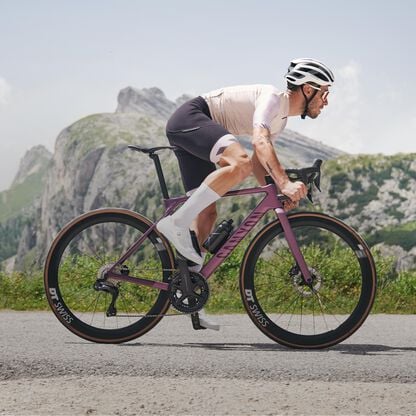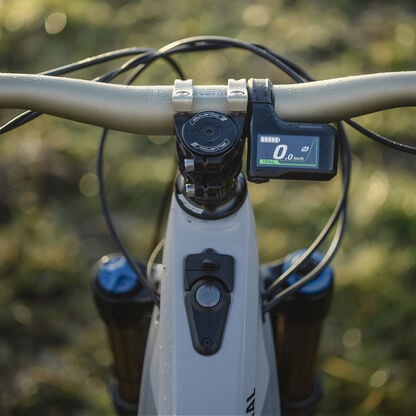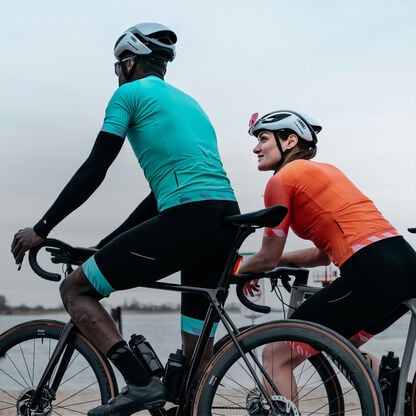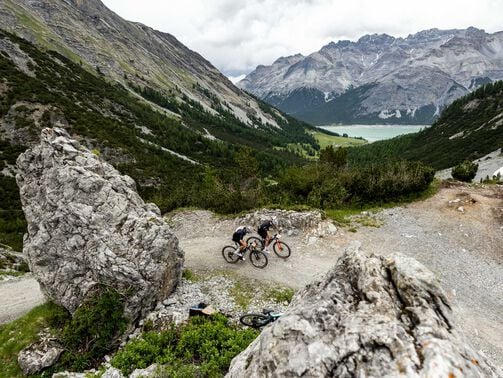Cycling in the rain: 8 tips for a safe and dry ride
Safe and dry riding even in the rain: With our 8 tips, cycling in the rain is a breeze.


Cycling in the rain requires more than just increased attention. With the right preparation and suitable technology, you will be safe and at ease on the road, even in bad weather. We will show you how to prepare for your journey and how to take proper care of your bicycle when it rains.
Contents
Why cycling requires special attention in the rain
Cycling in the rain can be refreshing and adventurous - but it also brings some challenges. Slippery roads and impaired vision increase your risk of coming off the bike. Good preparation and a healthy portion of caution are therefore key to reaching your destination safely. Cold and wet clothing are also the best recipe for colds and sniffles. The right clothing for cycling in the rain prevents you from getting cold and getting sick. And if you are caught unprepared, we have compiled a few tips in the advice on cycling with a cold for you.
Does rain damage your bicycle?
The short answer: Yes, rain is not your bicycle’s best friend. Wet conditions cause mechanical parts on your bike to rust, such as the sprocket or the chain, so that you have to replace them at some time. If you often ride a bicycle in the rain, it is all the more important that you maintain your bicycle regularly. Read our guide on how to clean and polish your bicycle properly.
Do you ride an e-bike? Then be sure to protect the battery from the rain. Also check whether all electronic parts are waterproof. You can find out what other special features apply in our guide on e-bikes in the rain.

How to prepare properly for a cycle ride in the rain
Sometimes you just have no other choice than riding your bike in the rain - whether its for training or because you have to work. We have a few tips for optimal preparation so that you can reach your destination dry.
Tip #1: Choose the right rain gear for comfort and protection
Do you want to stay dry and reach your destination safely without catching a cold? The right rain protection for your bicycle prevents your journey from becoming cold and wet. Here are the most important pieces of clothing:
- A good rain jacket: It protects you from the worst. Modern rain jackets not only keep you dry but are also breathable. Practical for long and strenuous trips where you sweat a lot.
- A suitable rain trousers: Make sure that the pants are long enough to cover your shoes.
- Overshoes for rain: Nothing is worse than wet feet. Use overshoes that keep your actual shoes dry.
- Water-repellent gloves: They help you to keep warm hands and the handlebar firmly under control while driving.
- A waterproof underhelmet cap: Did you know that you lose 30% of your body heat over your head? A waterproof and windproof cap protects your head from cooling down.
Extra tip: Even if you find it uncool - not least of all, mudguards stop splash water and mud from getting you wet.
Are you looking for the right bike accessories for winter or the next ride in the rain? Take a look at our range of bicycle clothing - all pieces are designed by us or are selected by leading brands.
Tip #2: Select the right tire and adjust the tire pressure
A racing bike tire with slight tread travels fast, but offers you little adhesion on wet roads. Therefore, bicycle tyres with a deep tread that have more contact with the substrate are better suited. If you ride regularly in winter, tires with spikes can make sense.
Regardless of which tires you are cycling with: Before riding, release 1 bar of pressure from the tire, so that:
- you have better adhesion on the road;
- unevenness and impacts are better cushioned, thus reducing your risk of skidding; and
- your braking distance is reduced due to greater surface contact with the road.
But make sure you do not reduce the tire pressure too much - otherwise you run the risk of having a flat tire.
Tip #3: Improve your lighting and increase your visibility
In rain and bad weather, visibility of cyclists is reduced and your own vision is even poorer. This results in two consequences:
#1: Improve your bicycle lighting: Whether day or night - cycle with the light switched on. This way, you will enlarge your field of vision and become aware of potential obstacles earlier. You also become even more visible at the same time.
#2: Improve your visibility: Colourful or reflective clothing helps drivers to see cyclists better on the road. Helmets or reflectors on the wheels are also eye-catching and prevent accidents before they happen.

How to ride a bike properly in the rain
You have the right clothing on, you have made sure that you are clearly visible, and you have selected the right tire. Now the question arises: Which cycling behavior is appropriate for the weather?
Tip #4: Be careful when braking
Be aware that the braking distance is significantly longer when it is raining and conditions are wet than on dry roads. This is because, one, your tires have less grip. And two, the brake blocks take longer to grip and to slow down your wheel. There are three rules you can follow:
- Avoid abrupt braking that causes you to skid. Brake gently and steadily instead.
- Do a light brake test to get a feel for how slippery the road is.
- Always cycle slower than in dry weather so that you can react faster.
Tip #5: Look out for slippery surfaces
Road markings, gullies or tramway tracks: not a problem in dry weather. When wet, however, they can turn into a dangerous ice rink for bicycles. When cycling, keep a look out for potentially slippery surfaces and avoid them as far as possible. Caution is advised for puddles, since often you do not know how deep they are and what is hidden underneath.
Tip #6: Ride in anticipation
Let’s summarize: When cycling in the rain, you are not as visible, your own vision is poorer, and your braking distance is longer than normal. Do not underestimate the risk that your reaction time could not be enough in this case. An anticipatory cycling style is paramount to arriving safe and sound - especially when the roads are not only wet but also slippery.

How to care for and maintain your bike after a ride in the rain
Have you arrived home dry and safe? Wonderful! Now take another 5 minutes to give your bicycle some care. You will thus significantly extend the lifespan of your bike. This is how it works:
Tip #7: Maintain and oil your chain
Your chain needs a good clean and needs to be oiled after a ride in the rain. First clean the chain with chain cleaner or a soft cloth to remove any dirt and moisture. Then oil the chain with chain oil, making sure to apply the oil evenly so that it can penetrate all links. This protects your chain from rust and wear and tear and ensures a pleasant, smooth cycling experience.
Here you will find a detailed guide on how to clean your bicycle chain properly.
Tip #8: Clean your tires
Your tires should also be cleaned after a cycle ride in the rain. Wipe off sludge, sand and other residues with a cloth or remove them with a brush. Pay particular attention to the tire tread - dirt often gets stuck there, which reduces adhesion to wet roads.
How to transport your bicycle in the rain
On the roof, on the rear rack or in the car: How to transport your bicycle properly and safely in inclement weather
Safe transportation methods in wet conditions
It is best to transport your bicycle inside the car. This prevents your bicycle from getting wet at all and protects the sensitive parts from splash water. If you want to transport your bike on the outside on a rear or roof rack, it is important to protect the bicycle from the rain.
Protective measures during transportation
Waterproof protective covers protect your bicycle from rain and splash water when transporting it on the roof or rear rack. You should especially protect sensitive parts such as the chain or electrical connections on e-bikes or remove them completely to protect them from moisture. Inspect your bicycle after transporting it and check whether a quick clean is necessary.
Did this article help?
Thank you for your feedback










